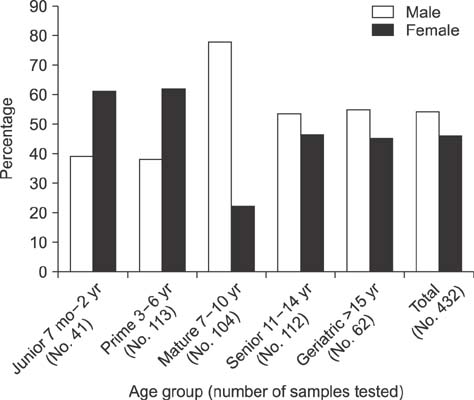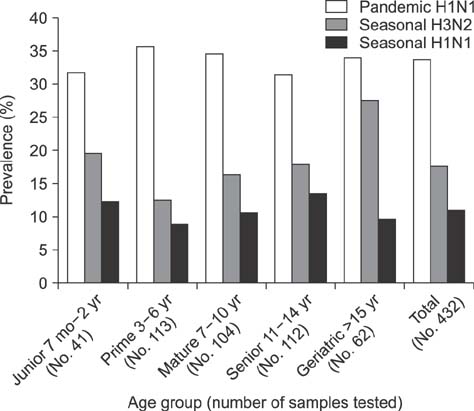J Vet Sci.
2016 Dec;17(4):515-521. 10.4142/jvs.2016.17.4.515.
Post-pandemic seroprevalence of human influenza viruses in domestic cats
- Affiliations
-
- 1Food Animal Health Research Program, Ohio Agricultural Research and Development Center, The Ohio State University, Wooster, OH 44691, USA. lee.2854@osu.edu
- 2Department of Veterinary Clinical Science, College of Veterinary Medicine, The Ohio State University, Columbus, OH 43210, USA.
- 3Department of Birds and Rabbit Medicine, Faculty of Veterinary Medicine, University of Sadat City, Menoufiya 32897, Egypt.
- 4Department of Poultry Diseases, Faculty of Veterinary Medicine, Beni-Suef University, Beni Suef 62511, Egypt.
- 5Department of Veterinary Preventive Medicine, College of Veterinary Medicine, The Ohio State University, Columbus, OH 43210, USA.
- KMID: 2412607
- DOI: http://doi.org/10.4142/jvs.2016.17.4.515
Abstract
- The continuous exposure of cats to diverse influenza viruses raises the concern of a potential role of cats in the epidemiology of these viruses. Our previous seroprevalence study of domestic cat sera collected during the 2009 H1N1 pandemic wave (September 2009-September 2010) revealed a high prevalence of pandemic H1N1, as well as seasonal H1N1 and H3N2 human flu virus infection (22.5%, 33.0%, and 43.5%, respectively). In this study, we extended the serosurvey of influenza viruses in cat sera collected post-pandemic (June 2011-August 2012). A total of 432 cat sera were tested using the hemagglutination inhibition assay. The results showed an increase in pandemic H1N1 prevalence (33.6%) and a significant reduction in both seasonal H1N1 and H3N2 prevalence (10.9% and 17.6%, respectively) compared to our previous survey conducted during the pandemic wave. The pandemic H1N1 prevalence in cats showed an irregular seasonality pattern in the post-pandemic phase. Pandemic H1N1 reactivity was more frequent among female cats than male cats. In contrast to our earlier finding, no significant association between clinical respiratory disease and influenza virus infection was observed. Our study highlights a high susceptibility among cats to human influenza virus infection that is correlated with influenza prevalence in the human population.
MeSH Terms
-
Animals
Antibodies, Viral/*blood
Cat Diseases/blood/*epidemiology
Cats
Female
Hemagglutination Inhibition Tests/veterinary
Humans
Influenza A Virus, H1N1 Subtype/immunology/*isolation & purification
Influenza A Virus, H3N2 Subtype/immunology/*isolation & purification
Male
Ohio/epidemiology
Orthomyxoviridae Infections/*blood/*epidemiology
Prevalence
Seasons
Seroepidemiologic Studies
Antibodies, Viral
Figure
Reference
-
1. Ali A, Daniels JB, Zhang Y, Rodriguez-Palacios A, Hayes-Ozello K, Mathes L, Lee CW. Pandemic and seasonal human influenza virus infections in domestic cats: prevalence, association with respiratory disease, and seasonality patterns. J Clin Microbiol. 2011; 49:4101–4105.
Article2. Campagnolo ER, Rankin JT, Daverio SA, Hunt EA, Lute JR, Tewari D, Acland HM, Ostrowski SR, Moll ME, Urdaneta VV, Ostroff SM. Fatal pandemic (H1N1) 2009 influenza A virus infection in a Pennsylvania domestic cat. Zoonoses Public Health. 2011; 58:500–507.
Article3. Chang S, Ding Z, Yang ST, Gao YW, Zou XH, Wang TC, Xia XZ. Study on the histopathology of cats inoculated with H5N1 subtype high pathogenic avian influenza virus originated from tigers. Bing Du Xue Bao. 2007; 23:477–480.4. Chen Y, Zhang J, Qiao C, Yang H, Zhang Y, Xin X, Chen H. Co-circulation of pandemic 2009 H1N1, classical swine H1N1 and avian-like swine H1N1 influenza viruses in pigs in China. Infect Genet Evol. 2013; 13:331–338.
Article5. Comin A, Toft N, Stegeman A, Klinkenberg D, Marangon S. Serological diagnosis of avian influenza in poultry: is the haemagglutination inhibition test really the 'gold standard'? Influenza Other Respir Viruses. 2013; 7:257–264.
Article6. Damiani AM, Kalthoff D, Beer M, Müller E, Osterrieder N. Serological survey in dogs and cats for influenza A(H1N1)pdm09 in Germany. Zoonoses Public Health. 2012; 59:549–552.
Article7. Driskell EA, Jones CA, Berghaus RD, Stallknecht DE, Howerth EW, Tompkins SM. Domestic cats are susceptible to infection with low pathogenic avian influenza viruses from shorebirds. Vet Pathol. 2013; 50:39–45.
Article8. Fiorentini L, Taddei R, Moreno A, Gelmetti D, Barbieri I, De Marco MA, Tosi G, Cordioli P, Massi P. Influenza A pandemic (H1N1) 2009 virus outbreak in a cat colony in Italy. Zoonoses Public Health. 2011; 58:573–581.
Article9. Gordy JT, Jones CA, Rue J, Crawford PC, Levy JK, Stallknecht DE, Tripp RA, Tompkins SM. Surveillance of feral cats for influenza A virus in north central Florida. Influenza Other Respir Viruses. 2012; 6:341–347.
Article10. Harder TC, Vahlenkamp TW. Influenza virus infections in dogs and cats. Vet Immunol Immunopathol. 2010; 134:54–60.
Article11. Hinshaw VS, Webster RG, Easterday BC, Bean WJ Jr. Replication of avian influenza A viruses in mammals. Infect Immun. 1981; 34:354–361.
Article12. Jeoung HY, Lim SI, Shin BH, Lim JA, Song JY, Song DS, Kang BK, Moon HJ, An DJ. A novel canine influenza H3N2 virus isolated from cats in an animal shelter. Vet Microbiol. 2013; 165:281–286.
Article13. Jeoung HY, Shin BH, Lee WH, Song DS, Choi YK, Jeong W, Song JY, An DJ. Seroprevalence of subtype H3 influenza A virus in South Korean cats. J Feline Med Surg. 2012; 14:746–750.
Article14. Löhr CV, DeBess EE, Baker RJ, Hiett SL, Hoffman KA, Murdoch VJ, Fischer KA, Mulrooney DM, Selman RL, Hammill-Black WM. Pathology and viral antigen distribution of lethal pneumonia in domestic cats due to pandemic (H1N1) 2009 influenza A virus. Vet Pathol. 2010; 47:378–386.
Article15. McCullers JA, Van De Velde LA, Schultz RD, Mitchell CG, Halford CR, Boyd KL, Schultz-Cherry S. Seroprevalence of seasonal and pandemic influenza A viruses in domestic cats. Arch Virol. 2011; 156:117–120.
Article16. Palese P, Wang TT. Why do influenza virus subtypes die out? A hypothesis. MBio. 2011; 2:e00150-11.
Article17. Paltrinieri S, Spagnolo V, Giordano A, Martin AM, Luppi A. Influenza virus type A serosurvey in cats. Emerg Infect Dis. 2007; 13:662–664.
Article18. Paniker CKJ, Nair CMG. Infection with A2 Hong Kong influenza virus in domestic cats. Bull World Health Organ. 1970; 43:859–862.19. Pariani E, Amendola A, Ranghiero A, Anselmi G, Zanetti A. Surveillance of influenza viruses in the post-pandemic era (2010-2012) in Northern Italy. Hum Vaccin Immunother. 2013; 9:657–666.
Article20. Pica N, Hai R, Krammer F, Wang TT, Maamary J, Eggink D, Tan GS, Krause JC, Moran T, Stein CR, Banach D, Wrammert J, Belshe RB, García-Sastre A, Palese P. Hemagglutinin stalk antibodies elicited by the 2009 pandemic influenza virus as a mechanism for the extinction of seasonal H1N1 viruses. Proc Natl Acad Sci U S A. 2012; 109:2573–2578.
Article21. Piccirillo A, Pasotto D, Martin AM, Cordioli P. Serological survey for influenza type A viruses in domestic dogs (Canis lupus familiaris) and cats (Felis catus) in north-eastern Italy. Zoonoses Public Health. 2010; 57:239–243.
Article22. Rasmussen SA, Jamieson DJ, Uyeki TM. Effects of influenza on pregnant women and infants. Am J Obstet Gynecol. 2012; 207:3 Suppl. S3–S8.
Article23. Rimmelzwaan GF, van Riel D, Baars M, Bestebroer TM, van Amerongen G, Fouchier RAM, Osterhaus ADME, Kuiken T. Influenza A virus (H5N1) infection in cats causes systemic disease with potential novel routes of virus spread within and between hosts. Am J Pathol. 2006; 168:176–183.
Article24. Romváry J, Rózsa J, Farkas E. Infection of dogs and cats with the Hong Kong influenza A (H3N2) virus during an epidemic period in Hungary. Acta Vet Acad Sci Hung. 1975; 25:255–259.25. Said AW, Usui T, Shinya K, Ono E, Ito T, Hikasa Y, Matsuu A, Takeuchi T, Sugiyama A, Nishii N, Yamaguchi T. A sero-survey of subtype H3 influenza A virus infection in dogs and cats in Japan. J Vet Med Sci. 2011; 73:541–544.
Article26. Shafir SC, O'Keefe KA, Shoaf KI. Evaluation of the seroprevalence of influenza A(H1N1) 2009 on a university campus: a cross-sectional study. BMC Public Health. 2011; 11:922.
Article27. Shriner SA, VanDalen KK, Mooers NL, Ellis JW, Sullivan HJ, Root JJ, Pelzel AM, Franklin AB. Low-pathogenic avian influenza viruses in wild house mice. PLoS One. 2012; 7:e39206.
Article28. Song DS, An DJ, Moon HJ, Yeom MJ, Jeong HY, Jeong WS, Park SJ, Kim HK, Han SY, Oh JS, Park BK, Kim JK, Poo H, Webster RG, Jung K, Kang BK. Interspecies transmission of the canine influenza H3N2 virus to domestic cats in South Korea, 2010. J Gen Virol. 2011; 92:2350–2355.
Article29. Songserm T, Amonsin A, Jam-on R, Sae-Heng N, Meemak N, Pariyothorn N, Payungporn S, Theamboonlers A, Poovorawan Y. Avian influenza H5N1 in naturally infected domestic cat. Emerg Infect Dis. 2006; 12:681–683.
Article30. Su S, Yuan L, Li H, Chen J, Xie J, Huang Z, Jia K, Li S. Serologic evidence of pandemic influenza virus H1N1 2009 infection in cats in China. Clin Vaccine Immunol. 2013; 20:115–117.
Article31. Swayne DE, Senne DA, Beard CW. Avian influenza. In : Swayne DE, editor. A Laboratory Manual for the Isolation and Identification of Avian Pathogens. 4th ed. Kennett Square: American Association of Avian Pathologists;1998. p. 150–155.32. Unsematham S, Ketbumrongporn W, Boonthongtho K. Associated factors for diagnosis of influenza A (H1N1) 2009 in patients presenting to Rajavithi Hospital. J Med Assoc Thai. 2012; 95:Suppl 3. S16–S21.33. van den Brand JM, Stittelaar KJ, van Amerongen G, van de Bildt MW, Leijten LM, Kuiken T, Osterhaus AD. Experimental pandemic (H1N1) 2009 virus infection of cats. Emerg Infect Dis. 2010; 16:1745–1747.
Article34. van Riel D, Munster VJ, de Wit E, Rimmelzwaan GF, Fouchier RA, Osterhaus AD, Kuiken T. Human and avian influenza viruses target different cells in the lower respiratory tract of humans and other mammals. Am J Pathol. 2007; 171:1215–1223.
Article35. van Riel D, Rimmelzwaan GF, van Amerongen G, Osterhaus ADME, Kuiken T. Highly pathogenic avian influenza virus H7N7 isolated from a fatal human case causes respiratory disease in cats but does not spread systemically. Am J Pathol. 2010; 177:2185–2190.
Article36. Wane J, Nyatanyi T, Nkunda R, Rukelibuga J, Ahmed Z, Biedron C, Kabeja A, Muhimpundu MA, Kabanda A, Antara S, Briet O, Koama JB, Rusanganwa A, Mukabayire O, Karema C, Raghunathan P, Lowrance D. 2009 pandemic influenza A (H1N1) virus outbreak and response—Rwanda, October, 2009-May, 2010. PLoS One. 2012; 7:e31572.37. Ward KA, Spokes PJ, McAnulty JM. Case–control study of risk factors for hospitalization caused by pandemic (H1N1). Emerg Infect Dis. 2011; 17:1409–1416.38. World Organisation for Animal Health. Avian influenza. Manual of Diagnostic Tests and Vaccines for Terrestrial Animals (Mammals, Birds and Bees). 6th ed. Vol. 1. Paris: Office International des Epizooties;2008. p. 465–481.39. Yassine HM, Lee CW, Gourapura R, Saif YM. Interspecies and intraspecies transmission of influenza A viruses: viral, host and environmental factors. Anim Health Res Rev. 2010; 11:53–72.
Article40. Zhang K, Zhang Z, Yu Z, Li L, Cheng K, Wang T, Huang G, Yang S, Zhao Y, Feng N, Fu J, Qin C, Gao Y, Xia X. Domestic cats and dogs are susceptible to H9N2 avian influenza virus. Virus Res. 2013; 175:52–57.
Article
- Full Text Links
- Actions
-
Cited
- CITED
-
- Close
- Share
- Similar articles
-
- Challenges of influenza A viruses in humans and animals and current animal vaccines as an effective control measure
- Overview of Pandemic Influenza
- Epidemiology and Pandemic Risk Assessment of Avian Influenza
- Vaccine Strategy for Influenza A (H1N1) Pandemic
- Epidemiology, clinical manifestations, and management of pandemic novel Influenza A (H1N1)





